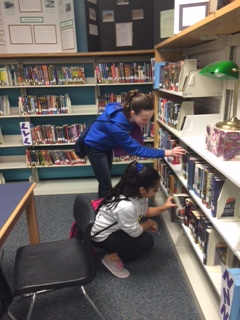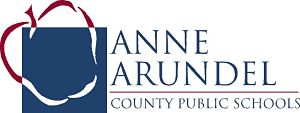Imagine yourself at a school library—what do you see? A silent space filled with rows of books where students can sit by themselves to work on homework or read, right?

Like all effective Media Specialists, Wendy works hard to create a space that is bright, stuffed with books, and a place where everyone can feel comfortable.
Now let’s step into the media center at Belvedere Elementary School. It’s before school and 1st graders are walking in, book in hand, for book club. The students are met by 5th grade students who lead them to a rug at the side of the room; they sit down together and start talking about the story the younger student read at home. At the back of the room, another group of 5th graders are running through their script in the “studio,” adjusting the camera to prepare for the morning announcements they will be broadcasting throughout the school. A few other students are finishing up class assignments on the computers at the front of the room and a group of girls are giggling in the corner as they help to place books back on the shelves.
In the center of this whirlwind of activity is Media Specialist (also referred to as School Librarian) Wendy West. She acknowledges that their school library is busy, but, she says, that is the way it is supposed to be: “The library should be the center of the school and should be a meeting place for everyone…a space for everyone—for teachers, for students—for everyone to feel comfortable.”
Wendy’s approach reflects the vision for all school libraries within Anne Arundel County. Making it clear that this isn’t your grandparent’s library, the Office of Digital Media’s vision statement explains that school libraries should be “the hub of the school and [should be] innovative, vibrant, and flexible spaces, staffed with school librarians who inspire students to become tech savvy and independent life-long readers and learners.” To turn this vision into a reality, Anne Arundel County Public Schools and the Office of Digital Media Services depend on their vibrant team of 126 creative, dedicated, and passionate Media Specialists.
Supporting the Schools as Teacher Librarians
A class of 5th grade Belvedere Elementary School students are walking into the school library to work on their biography research project. Over the past few weeks, Wendy has worked with students to find information about an important figure from the American Revolution and today they are creating their final projects in their choice of Powerpoint, Wixie, or Movie Maker. As Wendy walks around the room to answer questions and show students tricks for using the computer, it is clear that her role in this space is first and foremost a teacher. “I feel like I’m an extension of the classroom,” she says, which is why Wendy works so closely with the other teachers at the school to identify ways that she can support that work already occurring in the classroom.
Whether in an elementary, middle, or high school library, all media specialists actively work with teachers to figure out how they can use their own expertise to compliment and support classroom instruction. Today’s media specialists are experts not only on the physical technology and resources available in their school’s library, but also on ways to integrate those resources into the curriculum. Many are experienced classroom teachers, who have advanced degrees in Instruction Technology, School Librarianship, or Library Science (MLS). Following the same best teaching practices used by every great teacher, media specialists differentiate their lessons to meet the needs of their students, colleagues, and schools. From adjusting a dictionary lesson to focus on 3rd grade math terms, to developing a series of tutorials to help 7th grade students master Microsoft Word, to creating a research project that integrates print and online resources into a 10th grade English class, Media Specialists provide all students with an additional teacher ready and willing to support their education.
Being a 21st Century School Librarians
During first period at Severna Park High School, School Librarian Marianne Fitzgerald is helping a group of students in the school’s Introduction to Teaching class with their history of teaching research project that Marianne has helped Ms. McFarland, the course teacher, organize over the past few years. As in the past, the students have spent the past two weeks in the media center to use books and online databases to research a topic and develop a thesis statement. But this year, instead of asking students to write an essay, Marianne suggested using infographics to share the students’ research in a more visual way. Ms. McFarland loved the idea and let Marianne share examples of successful thesis-driven infographics and walk students through creating their own graphics online. Ms. McFarland has found that the students are already enjoying the project more than they have in the past, in part because it allows her class to practice and develop their research and presentation skills without requiring a traditional written report.

AACPS Media Centers offer students access to a combined total of 3,035 computers, allow students access to technology–often technology they do not have at home. (Photo Credit: Marianne Fitzgerald, SPHS, 2015)
Marianne is always on the lookout for creative ways to engage students. Unlike elementary schools where all students come to the media center as part of their weekly schedule, middle and high school librarians need to be more proactive in reaching out to teachers and students alike. Marianne looks at the curriculum throughout the school and offers suggestions to make potentially stagnant lessons more dynamic. From finding an app that could help a teacher enhance a geometry class to creating a lesson that integrates the library’s Makerspace into a unit on the Industrial Revolution, Marianne loves any opportunity to bring a new twist to an old project. “The school library is a place to learn, but students learn in so many different ways, not just books and text books,” she says, “school librarians should be that hub.”
Going far beyond “just books and text books,” media specialists are responsible for exposing students to, and helping them navigate, a wide range of digital tools and resources. Often, this means integrating technology into the media center through tablets, apps, online games and coding programs. In addition to their lessons for students, media specialists lead professional development to help teachers and other school staff members use different types of technology and incorporate it into their instruction.
But beyond increasing access to technology, media specialists also understand that being 21st Century School Librarians means helping students understand how to find, use, and communicate information—from all sources—effectively and responsibly. While information is now available at our fingertips, not all of it is accurate and reliable. Media specialists help students understand the difference between information found on Wikipedia and that from a more trustworthy source. In addition to its printed materials, AACPS school libraries have access to over 50 online databases—including Discovery Education, ProQuest CultureGrams, and Britannica Academic, among many others. Accessible at home and at school, these databases provide students, families, and even teachers with extensive sources of reliable information across a wide range of topics.
To meet the ever-changing needs of their students and their schools, today’s media specialists must be willing to wear many hats, from master teacher to database expert to technology leader. The dynamic team of AACPS School Librarians provide the community access to specialists who are “part wizard, part genius, part explorer,” able and willing to step up as trailblazers of innovation within their schools and find creative ways to engage student and teachers in learning. But while all of their roles are important, one of the most important responsibilities of a school librarian is also one of the oldest—to encourage all students to become life-long readers.
Inspiring Our Students to Love Reading
At Magothy River Middle School, small groups of 6th grade students sit around the media center discussing books with group leaders. Taking turns, the students share their favorite character and compare their favorite scenes, laughing as they relay some of the particularly funny parts of the novels’ plots. This Recreational Reading Program is a favorite of Media Specialist Amanda McDowell, who works with 6th and 7th grade English classes to pick a selection of books for each class and organize parent and community volunteers to facilitate the discussions. The goal of the program is to show students the wide variety of books available to them and encourage them to try something new—and it seems to be working. One of today’s students said, “I like [the program] because sometimes I go to the library and can’t figure out what book I like but this lets me learn about a bunch of them and try one.”

While a lot has changed for Media Specialists over the past decade, inspiring students to love reading is still one of their most important roles. (Photo Credit: Amanda McDowell, Magothy River Middle, 2016)
Amanda is passionate about the program because, like all school librarians, she loves seeing students engaged in reading. “To get a child interested in reading and getting a child to become a reader is just AMAZING!” She says, “The more books I expose the kids to, the more chance of that child becoming a life-long reader and someone who loves to read.” To this end, media specialists are constantly looking for new ways to create a welcoming space.
A large part of this lies in creating a collection that entices their students. While AACPS already has a collection of books, periodicals, e-books, and other materials that totals over 1.8 million items (as of 2016), the collection is constantly being refreshed to keep up with popular releases and students’ own changing interests. Amanda, for example, found that while a lot of younger students checked out books regularly, 8th grade students were less interested in the books available. So, she created an “8th Grade Only” section that gave older students access to books at a higher reading level and with more mature storylines. On the day she introduced the initiatives to students, the shelves were cleared by the end of first period, clearly showing the success of the program.
But even beyond the selection of books, a successful school library is inviting to everyone in the school community. Many media centers across the county have sets of over-stuffed furniture and media specialists encourage students and staff alike to think of the library as a space they can go to for help, information, or just a friendly conversation in the middle of a busy day. Because no matter how the space is being used, media specialists know that the more people who come into the school library, the more people who will see it as a resource at the center of the school. “It is the heart of everything,” Amanda says. “It involves technology, reading–it is the heart and support of all the initiatives we’re trying to get kids to learn. It’s all here.”

